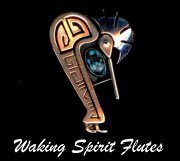| Frequently Asked Questions |
| Placement of the Block/Fetish |
Question: I have been told, and have read in many flute tutorials, that the Block should be placed up against the back edge of the True Sound Hole. However, a few flute makers state that their Block should be placed a fraction back from the TSH. Can you explain why this is? Answer: This is one of the most problematic scenarios in the Native American Flute world. There have been many occasions, especially at flute venues, when I have witnessed a flute player adjust a block so that it was sited up against the back edge of the True Sound Hole only to find the flute did not play too well. When the flute maker informed them that the Block should be placed slightly back from the TSH, they have replaced the flute on the seller's table because they think the flute has not been correctly made. They could NOT be more WRONG! The uncertainty of where to place a block basically arises from ignorance! As much as I hate to state this fact, it is true. Facilitators of Native American Flute institutions, Native American Flute 'advice' websites and flute teachers all give liberal advice on the subject of Block placement and flute making but I have yet to encounter one who actually understands the 'physics' involved in creating this instrument. As a result of this 'ignorance' their advice is often poor or totally incorrect. Creating a quality Native American Flute is a precise science because the playability and tuning of the flute is all governed by Mother Nature. Many times I have been condemned for using math and physics to create my flutes because it is assumed that Native American Flutes should never be created in this way as it is unnatural. Well, I can assure them that creating an instrument that allows Mother nature to do all the things She does when a flute is played IS quite natural! So, block placement will depend on how a flute is created. Using my flutes as an example, I will create it measuring and calculating the correct bore size for maximum playability, the containment (for precise fingering hole placement), the K1 (for correct flute length), the K2 (for correct embouchure sizing), wall thickness (also for fingering hole placement/tuning) and BREATH PRESSURE. I create my instruments using what I call The Breath of Life System which I developed many years ago. What this does is to allow the flute player to play the instrument with just the minimum amount of breath pressure. Needless to say, this has many, many advantages! The sum of all this determines where the block needs to be placed because not only does the flute need to play with little breath pressure, it needs to respond if a flute player blows harder into it. Being able to do this evolves around that little column of air that flows between the base of the Block and the TSH when the flute is played. When a TSH/embouchure is precisely calculated and created the length of it (from the bridge towards the foot) will be less that the air pressure needed to make it play notes. As a result of this, mathematically/physically, the block needs to be back from the TSH just a fraction (between 2 & 3 64ths of one inch). This placement is both correct and TOTALLY natural. So, my advice to you is to check with the flute maker where the block needs to be or experiment by finding the place where the flute plays at its best. Please do not expect the block to be up against the TSH and please ignore advise given by those who are not qualified to give it. |


